If you want to learn about lactate testing, you’ve come to the right place.
In this resource, you’ll learn everything you need to know, from the basics of lactate as a molecule, all the way to lactate testing for athletes, what kinds of lactate tests exist, and even what lactate testing kits are available.
To make your navigation easier, we’ve included a table of contents linking to the different sections of this lactate testing guide.
Lactate Testing for Athletes
What is Lactate?
What is Lactate Testing?
Lactate Testing for Endurance Performance
Individual Lactate Responses in Athletes
Lactate Threshold Testing
Lactate Graph Interpretation
Lactate Testing Kit
VO2max Testing VS Lactate Testing
Limitations of Lactate Testing
Lactate Testing in Running
Lactate Testing in Cycling
Triathlon Lactate Testing
Lactate Testing in CrossFit
Protocol 41: Upside Strength Testing
Lactate Testing FAQ
What is Lactate?
Lactate is an important molecule of human metabolism. At its base, it is simply the byproduct of glycolysis. Glycolysis is the process of breaking down sugar molecules (glucose or glycogen) to recycle energy inside the body.

Lactate Testing in Progress…
Muscle Fatigue
For a long time, we blamed lactate for causing muscle fatigue. Instead, it turns out that lactate is an important fuel for our mitochondria. In addition to being a source of energy, it’s also an important signaling molecule inside the body.
Lactate Production
Interestingly, we produce lactate even at rest when oxygen availability is high. It is also the main gluconeogenic precursor inside the body. This means that it will help recreate glucose molecules. This takes place inside the liver via the Cori Cycle. For instance, about 30 percent of all glucose used during exercise actually comes from lactate.

A Metabolic Fuel
As illustrated by George Brooks in the seminal paper “Lactate in contemporary biology: a phoenix risen“, Lactate is the fulcrum of metabolism. To put it another way, lactate is the link between glycolytic metabolism and oxidative metabolism. Indeed, energy systems are all coupled together and work synergistically inside the human body.
Lactate Rises during Exercise
During exercise, lactate rises as the intensity increases. By measuring lactate (via lactate testing), we can optimize training, target different training adaptations, and more.
Let’s learn more about lactate testing.
What is Lactate Testing?
Initially reserved for laboratories, lactate tests can now be performed in the gym, at home, or in the field. During a lactate test, the athlete (or the coach/tester) collects blood samples using a lancet and a lactate analyser. The lancet punctures the skin and makes the drop blood accessible. The lactate analyzer supports disposable strips. It’s imperative to change the lactate strips after each sample.
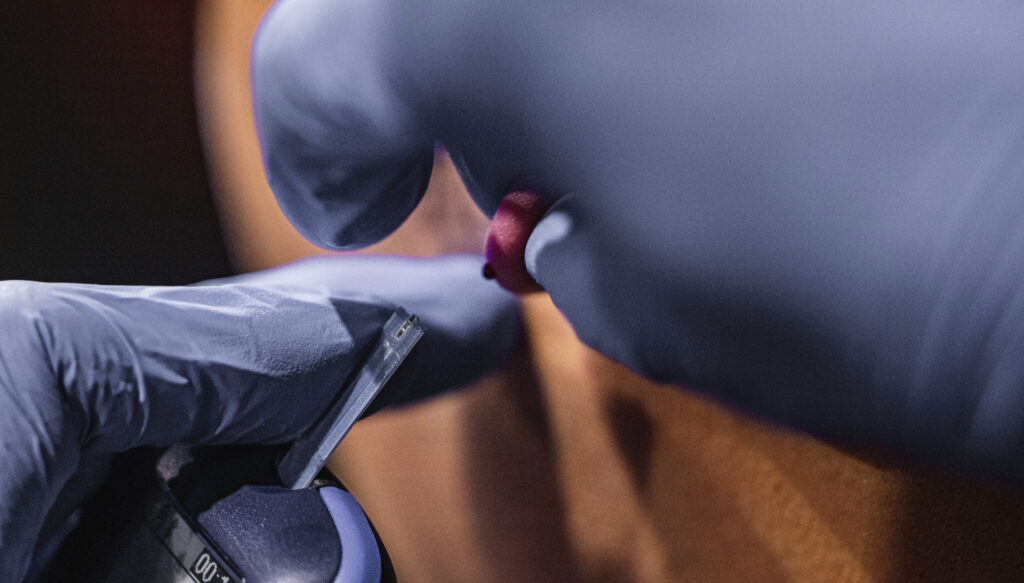
Given the invasive nature of the test, the person performing it should wear sterile and protective gloves. Common sampling spots are the finger and the earlobe. Therefore, if you administer a test to yourself, using the finger for the lactate sample is the most viable option.
What is the Goal of a Lactate Test?
The goal of a lactate test is to look at how lactate accumulates in the blood along the intensity spectrum. Unlike VO2 (oxygen consumption), blood lactate increases in a non-linear fashion. By plotting lactate against intensity (watts for cycling and speed for running, for example), we look for two major inflection points in the lactate curve. Those inflection points reflect changes in the body’s internal state. We commonly call them “thresholds” (or “lactate thresholds”).
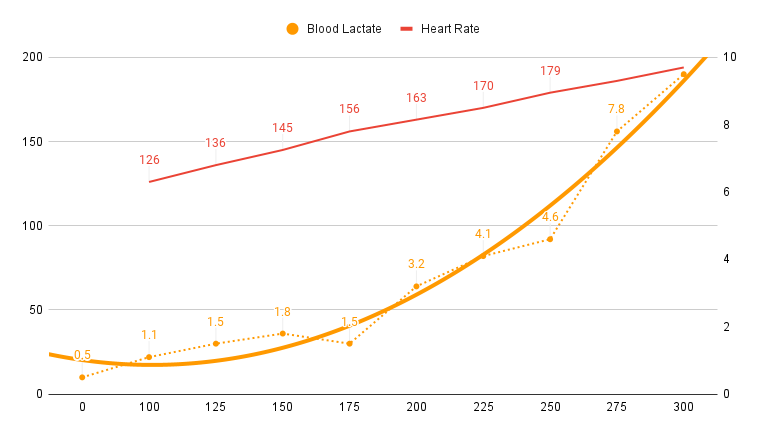
Knowing the lactate thresholds allows us to individualize training intensities for the athlete. Athletes who use training intensities based on their physiology ensure that each hour of training is moving them closer to their goal.
Another reason to perform a lactate test is to track progress over time. The athlete can perform a lactate test after important training blocs in order to quantify the effect the training had on their physiology. This can also help orient future training decisions based on the athlete’s profile, their strengths, weaknesses, and specific needs.
Besides lactate threshold tests, other kinds of lactate tests exist. You can, for example, measure your ability to clear lactate (“lactate clearance”) or even measure the athlete’s physiological response during a training session.
Essential Considerations for Lactate Testing by Jem Arnold
“What information do we hope to gain by measuring blood lactate (BLa)? Why do we want to know our lactate thresholds (LT)? I’ve heard it said that “finding a lactate threshold is like finding the corner of a circle.” What gives those ‘corners’ of the lactate curve any meaning? And how can we use that information? To me, there are two primary applications for lactate testing: 1. Athlete monitoring, and 2. Training prescription.
Athlete monitoring comes down to repeated testing under similar conditions to evaluate changes in our performance and physiology after training. Consistency matters most here. This is the strength of a standardized lactate test, to give us confidence that a measured change reflects a ‘real’ change beyond the expected day to day variability.

For training prescription, things can be a bit more complicated. A lactate test doesn’t closely resemble the demands of training or racing. BLa values during testing will not necessarily resemble BLa during training. LTs when fresh will not be the same after a set of hard intervals. Instead, we need to extrapolate from the test results based on what we know about physiology and our own responses to exercise, to predict and prescribe appropriate training. This is where the help of an experienced coach or expert becomes invaluable.
So what information can we get from lactate testing? The first step is consistent, reliable athlete monitoring to evaluate our training effectiveness. The second step is interpreting and extrapolating from the lactate curve to predict and thus prescribe training.”
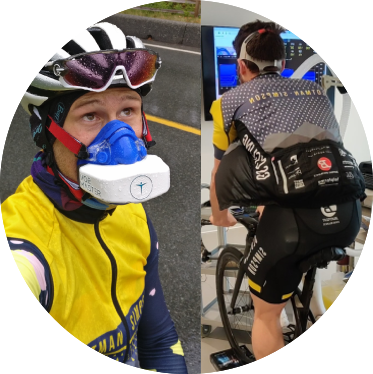
Contributor – Jem Arnold
Jem Arnold is a physiotherapist, endurance coach, and PhD student in Exercise Physiology at the University of British Columbia. He works with athletes returning to training from injury and advises on metabolic test design & interpretation. He posts on twitter @jem_arnold and writes at https://sparecycles.blog/
Heart Rate vs Lactate
Speaking in broad terms, the heart rate rises linearly with intensity (see graph above). Consequently, we will not see significant changes in the HR trend (inflection points) in the same way we do with lactate. For that reason, we shouldn’t use heart rate instead of lactate. We should rather use heart rate along with lactate.
By measuring lactate, intensity, and heart rate during the lactate test, we increase the precision of our monitoring.
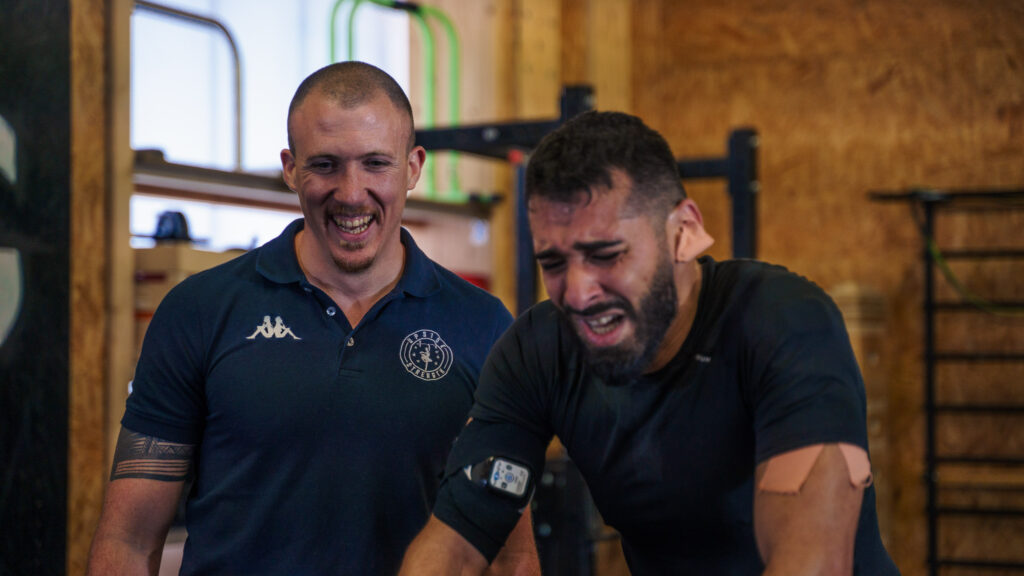
Lactate Testing for Endurance Performance
In endurance sports such as cycling or running, having a high lactate threshold is an important performance factor. Essentially, a high lactate threshold means that you can use a large fraction of your VO2 max while maintaining an internal steady state. In that way, you’re able to exercise for extended periods of time without going “into the red zone”.
For this reason, accurate lactate testing is a way to individualize training intensities and optimize performance in a very concrete way.
Individual Lactate Responses in Athletes
Many factors influence an athlete’s lactate response.
For example, genetics has an important effect on fiber type distribution. These fibers (Type I, IIa & IIx) have different metabolic profiles. This means that they employ different strategies to recycle ATP. While Type I fibers have a high mitochondrial and capillary density (high oxidative capacity), Type 2 fibers will be more inclined to rely on glycolysis. If an individual carries a lot of muscle mass (usually linked to a higher T2 fiber proportion), they will likely display higher glycolytic activity (and lower oxidative activity) compared to someone with the opposite profile.
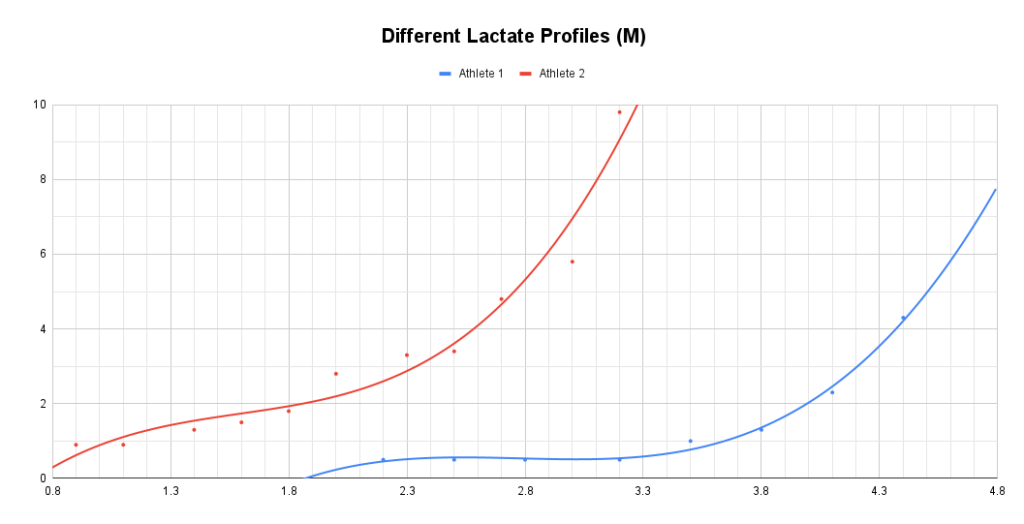
An athlete’s training background will also have a significant impact on their lactate response during exercise. Someone who has trained for many years in endurance sports will often exhibit a high oxidative capacity, leading to lower blood lactate values at a given speed or power. This lactate profile is very different from that of someone who trained for many years in a power sport with very little endurance training.
Lactate Threshold Testing Protocols
We can use different testing protocols along with lactate sampling. Each protocol has its own specific aim and should be chosen according to the context of the athlete being tested. Below you will find a few different popular protocols aimed at highlighting different facets of the athlete’s physiological profile.
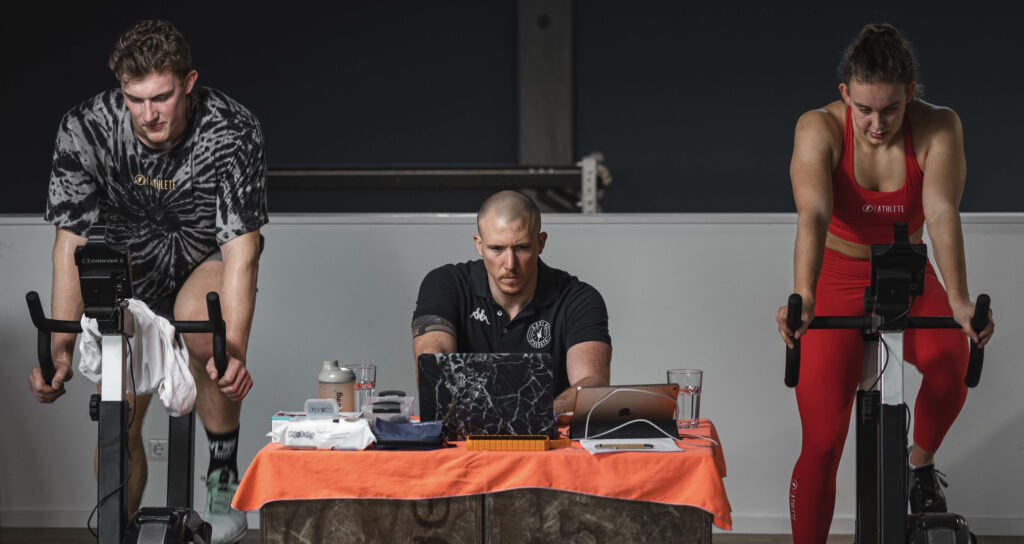
Lactate Step Test – Lactate Threshold Testing
A step test is a protocol that has the athlete go through a range of different intensities, often starting low and finishing high. In the context of lactate testing, interval durations of 4-10 minutes are recommended. Some prefer to include short rest intervals between each stage, while others don’t. The rest intervals, if used, allow the coach or the athlete to take better lactate samples.
The test should begin at a very low intensity (1/10 or RPE1). That way, the risk of missing the first lactate threshold (LT1) will be minimized. At the end of each work stage, the athlete or the coach samples the lactate from the earlobe or from the finger. This protocol should ideally last around 10 stages in order to get a complete view of the athlete’s metabolic profile.
Choosing the Right Lactate Threshold Testing Protocol
If the number of steps performed is much smaller than 10, the large power/speed increases between stages will make the interpretation less precise. Conversely, if the step increases are too small, the test might last a very long time. The key is to calibrate the test according to the athlete’s abilities. That way, we can find the best compromise between power increase between steps and total test duration.

This protocol can be used by beginners and elite athletes alike. The main objective is to determine the athlete’s lactate thresholds 1 & 2. Using this information, we can then individualize training intensities and orient the athlete’s training according to his/her strengths and weaknesses.
We should remember that these lactate thresholds aren’t perfect. However, they serve as a good model to break up the intensity spectrum into distinct domains. That way, we can more easily plan different types of training for the athlete.
Maximum Lactate Steady State – Lactate Threshold Testing
Maximum Lactate Steady State (MLSS) is defined as the highest workload (expressed in watts or speed) that can be maintained while blood lactate remains “stable”. Depending on who you ask, stable has varying definitions. For some, any increase in BLa over time indicates that the athlete has exceeded MLSS. Others allow a 0.9 mmol/L increase between minutes 10 and 30 of a 30-minute continuous effort. Needless to say, coaches use many different ways to determine MLSS.
When compared to the lactate step test described above, the MLSS test comes out on top in the precision department. Indeed, LT2 or lactate threshold is supposed to discriminate between stable and non-stable internal states. However, since the MLSS protocol requires multiple efforts of 30 minutes in duration, it is quite time-consuming. There have been attempts to come up with a one-day MLSS test protocol.
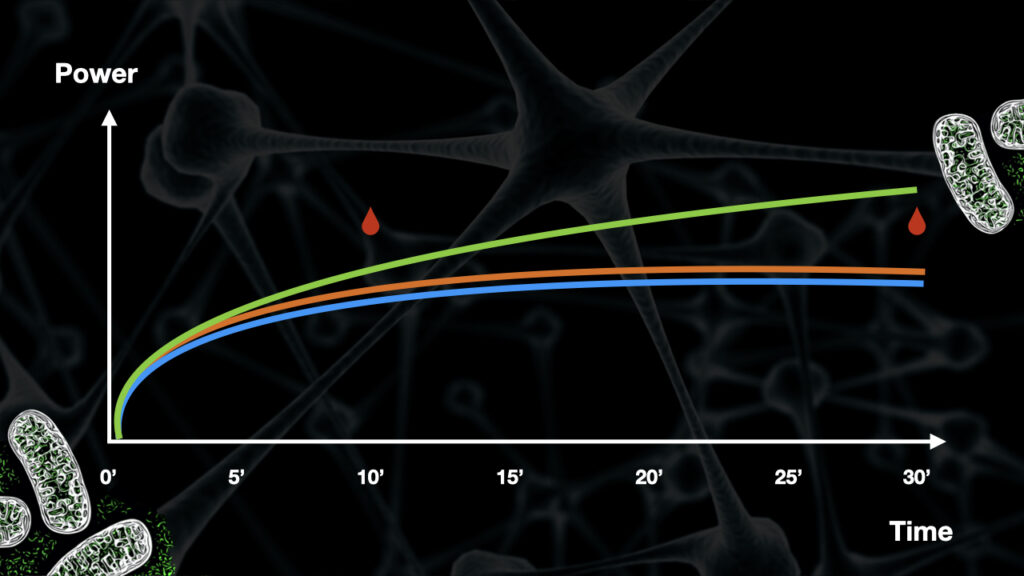
Theoretically, MLSS identifies the balance between lactate production and lactate clearance. This usually equates to the intensity that an athlete can sustain for 40 to 70 minutes. By knowing this steady-state value, we can be more precise when prescribing threshold training sessions for our athletes.
VLa Max Testing (Max Glycolytic Power)
VLa Max is meant to indicate the maximal production rate of lactate in your muscles. Note that we can only measure lactate in the blood so this is an imperfect metric. However, it can be a useful metric to help coaches track an athlete’s full metabolic profile.
The VLa Max test (also called glycolytic power or anaerobic capacity) should be performed when well rested. A 10-15′ active recovery phase should precede the VLa Max test. Once BLa is below 2.5 mmol/L, the test can begin.

The coach or athlete should take a lactate sample before the max effort sprint. Once the baseline value is known, the athlete performs an all-out effort for 10-15 seconds. Be sure to set the bike with a high enough resistance so that the athlete doesn’t spin out (not enough resistance) when expressing his/her max power.
After the 10-15-second effort, the athlete rests passively. That way, active recovery won’t influence the lactate values. We collect the lactate samples at minutes 3, 5, and 7 AFTER the sprint. If the readings keep increasing, more samples should be taken. The goal is to find the highest lactate value.
Calculating your VLa Max
We can then calculate the VLa Max by subtracting the baseline value (e.g. 1.5 mmol/L) from the max lactate value (e.g. 15.6 mmol/L). Then we divide the result by 16. This gives us a rough estimate of how powerful the athlete’s glycolytic system is. If we decide to also take one last sample 20 minutes after the test, we can calculate a lactate clearance rate.
The calculators below help you determine your VLa Max and your Lactate Clearance Rate. Coaches and athletes can also use dedicated software such as INSCYD to perform those tests and calculations. It is worth noting that the initial research conducted on this protocol required a very specific erg bike with precise resistance parameters. It might not be as accurate or useful when used outside of this context.
VLa Max Calculator
Lactate Clearance Calculator
Gordo Byrn on Submaximal Lactate Testing

Gordo Byrn is a past champion of Ultraman Hawaii and the ÖTillÖ SwimRun Worlds. He is a prolific creator of Endurance Sport content. You can find him on Twitter, YouTube and Substack.
“You are going to face two main challenges with applying lactate testing:
- Adapting information from the “lab” to the field
- Providing heart rate guidance to your athletes
When you read about lactate testing protocols, you’ll see they are nearly always Maximal. They go to athlete failure.
Maximal testing generates significant fatigue for the athlete and can disrupt the training program.
Enter Submaximal Testing:
- Step One: perform a normal progressive ramp test, but stop two steps after LT1
- Step Two: field test LT1 with a long steady-state interval where you note changes in lactate, heart rate, breathing, and RPE.
If Step Two shows stability in metrics then set a Zone 2 heart rate cap 5 bpm over the average for the final 2/3rds of the interval.
If Step Two does not show stability in metrics then adjust the power/pace target downwards until the athlete shows stability across the work interval.“
You’ll find case studies, video linksm and a more detailed explanation in Gordo Byrn’s article, The Importance of Submax Benchmarking on Endurance Essentials
Lactate Graph Interpretation
Following a lactate step test, the coach (or the athlete) needs to interpret the data. The difficult part of lactate graph interpretation is that there exist many methods to do so. The graph below illustrates the different interpretation methods known today.
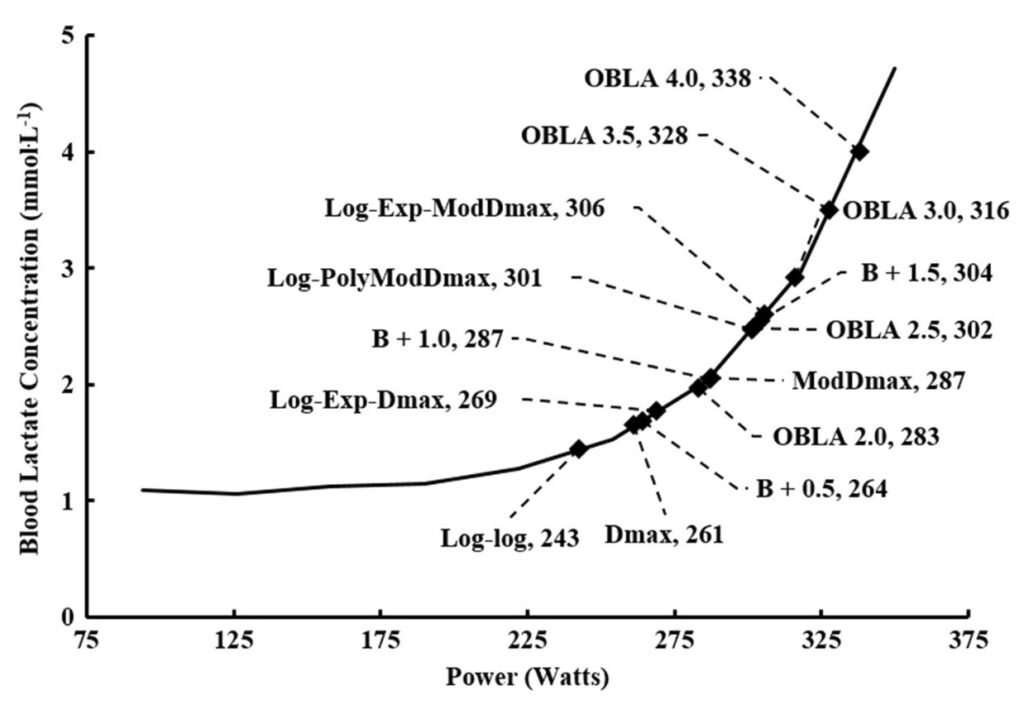
I personally use Bsn + 0.5 to find lactate threshold 1 and ModDMax to determine lactate threshold 2. From my perspective, there is no better or worse method. However, you MUST take the strengths and weaknesses of the chosen methods into account when you plan training around those values. You can find a detailed breakdown of different lactate curve interpretation methods here.
Lactate Testing Kit
In this section, I will compare different lactate testing devices available on the market. Lactate analyzers usually require disposable strips. You can only use each strip once. The strip serves as the interface between the blood droplet and the device. You can buy a lactate testing kit for anywhere between $200 and $350 depending on the model and the reseller.
Lactate Scout 4 – Lactate Testing Kit
The Lactate Scout 4 delivers fast lactate reading on its simple digital display. The device only requires a small volume of blood to function (0,2 µl of blood) and provides a reading in 10 seconds, making it one of the faster devices on the market.
To compensate for the influence of low or high hematocrit levels on the results, the Lactate Scout 4 is equipped with a hematocrit compensation tool. The admissible range of hematocrit to get a valid result is 20 to 70%.
This device is made to be used in a sport setting and is perfectly equipped for field lactate testing. The LS4 has the memory to store up to 500 results. The Lactate Scout 4 is also equipped with Bluetooth and can be connected to a smartphone or computer for easy data transfer.
Technical Specifications: Measured using enzymatic amperometric methods. Measurement range: 0.5 to 25 mmol/L. A timer is included. Purchase the Lactate Scout 4.
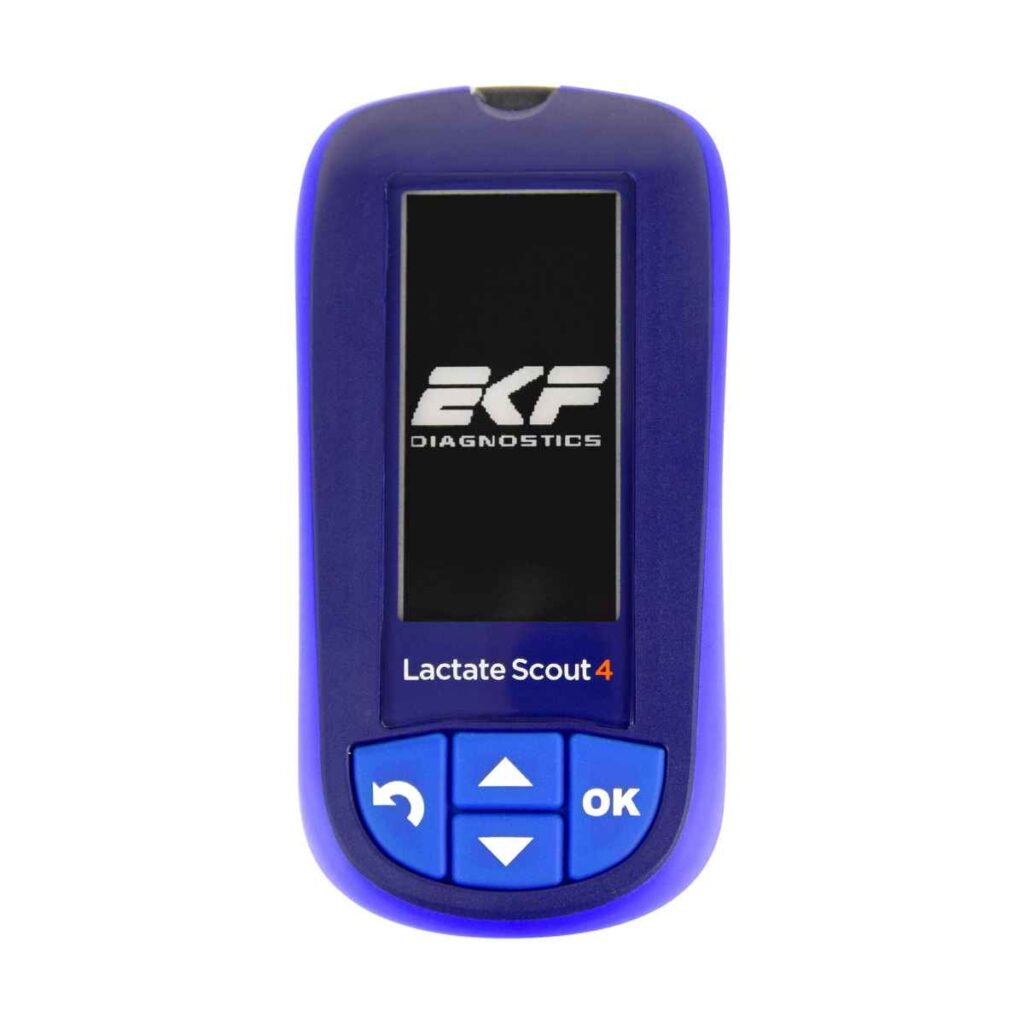
Lactate Plus Meter – Lactate Testing Kit
The Lactate Plus Meter is a tool intended for sports medicine professionals. It requires a reasonably small amount of blood (0,7 µl) and delivers a result in 13 seconds.
Lactate Plus is made by Nova Biomedical, a global leader in hospital-based blood lactate analyzers. Their products are used in more hospitals worldwide than any other lactate device. Consequently, the Lactate Plus is a highly reliable and accurate device.
This analyzer has an integrated test strip ejector that improves operational safety when testing multiple athletes at once. It can store up to 130 lactate testing results in its internal memory bank.
Technical Specifications: Measurement range: 0.3 to 25 mmol/L. Purchase the Lactate Plus Meter.
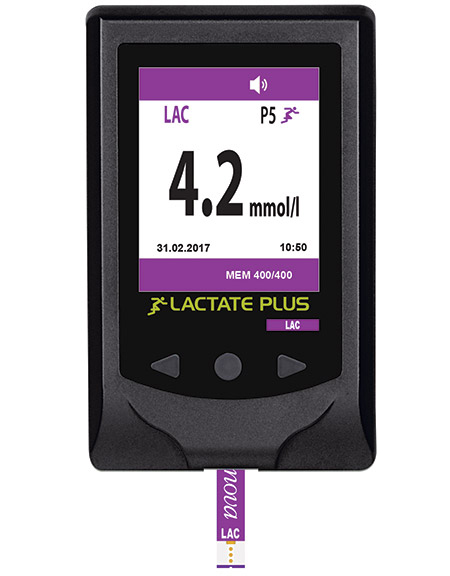
EDGE Lactate Meter – Lactate Testing Kit
The EDGE blood lactate meter is one of the more affordable lactate analyzer devices on the market. At around $200, it makes lactate testing accessible and available to a large number of athletes and coaches.
The EDGE delivers results in around 45 seconds. It only requires 0.3 µl of blood to function optimally. The blood lactate results are displayed in either mmol/L or in mg/dL.
The internal memory of this lactate analyzer holds up to 300 results. The manufacturer highlights the accuracy and precision of this device compared to lab-grade equipment.
Technical Specifications: Measurement range: 0.7 to 22.2 mmol/L. Purchase the EDGE Lactate Analyzer.
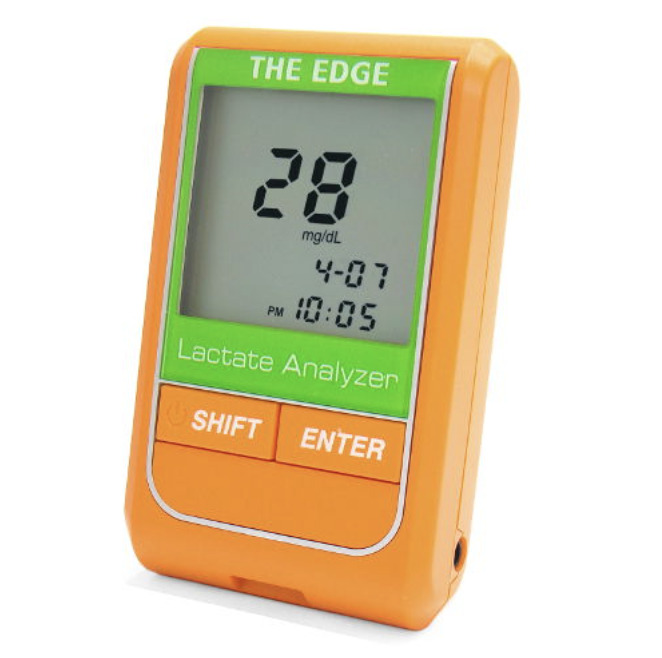
Lactate Pro 2 – Lactate Testing Kit
The Lactate Pro 2 analyzer is produced by Axonlab, a German company specializing in biomedical devices. The device only requires a small (0.3 µl) amount of whole blood and delivers the result in 15 seconds.
This analyzer stores up to 330 results in its memory bank. The results can then be transferred to a PC via a USB cable (included).
The manufacturer recommends letting the device adjust to environmental conditions for at least 20 minutes before using it.
Technical Specifications: Measurement range: 0.5 to 25 mmol/L. Purchase the Lactate Pro 2 Analyzer.

Lactate Analyzer Comparison Table
In this table, I will provide a side-by-side comparison of the different lactate testing devices and their characteristics.
| Characteristic | Lactate Scout 4 | Lactate Plus Meter | EDGE Lactate Meter | Lactate Pro 2 |
|---|---|---|---|---|
| Price | $365 | $312 | $200 | $340 |
| Measurement Time | 10 seconds | 13 seconds | 45 seconds | 15 seconds |
| Strip Cost | $2-2.5/strip | $1.9/strip | $1.9/strip | $1.9/strip |
| Measurement Range | 0.5-25 mmol/L | 0.3-25 mmol/L | 0.7-22.2 mmol/L | 0.5-25 mmol/L |
| Blood Sample Size | 0,2 µl | 0,7 µl | 0,3 µl | 0,3 µl |
| Memory Capacity | 500 | 130 results | 300 results | 330 results |
| Altitude Limit | 4000m | 4000m | 4000m | 4000m |
| Device Weight | 60 g | 75 g | 64 g | 50 g |
| Order Analyzer | Order Now | Order Now | Order Now | Order Now |
VO2max Testing VS Lactate Testing
VO2 max is the maximum amount of oxygen that the body can consume. As intensity goes up, so does our oxygen consumption until we reach VO2 max. The unit of measure for VO2 max is either in L/min if expressed in absolute terms, or ml/kg/min if expressed in relative terms. We can perform different kinds of VO2 max tests depending on what information we wish to garner.
A common test to determine an athlete’s VO2 max is a short ramp test lasting 9-15 minutes and completed to exhaustion. During this test, we increase the power/speed every minute which eventually elicits VO2 max. While a high VO2 max is a prerequisite for elite endurance performance, I would argue that in isolation, it is a less valuable metric than well-determined lactate thresholds.
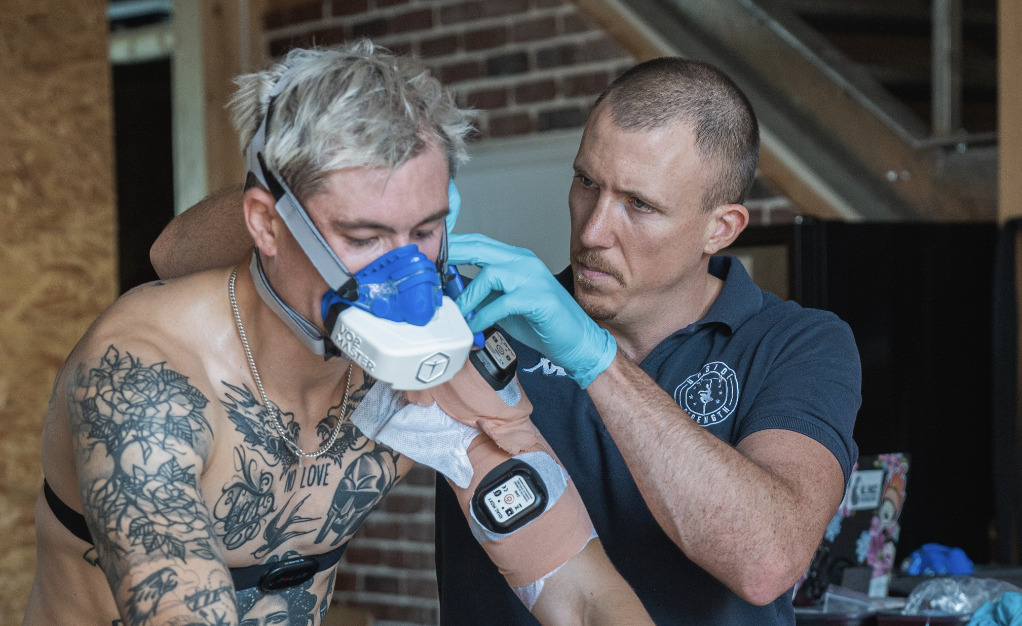
You can however measure both. During my complete physiological tests, I measure the following:
- Spirometry
- VO2 and VO2 max (using VO2 Master)
- Ventilation (how the athlete breathes)
- Lactate
- Muscle oximetry (using Moxy Monitor)
- Heart rate
- RPE (Rating of perceived exertion)
If we possess a tool that can measure CO2, it is possible to extract more precise ventilatory thresholds than with VO2 and ventilation alone. In that regard, VO2 testing is complementary to lactate testing. However, if the aim is to individualize the athlete’s training and track their metabolic development, I would argue in favor of lactate testing over VO2 max testing.
Limitations of Lactate Testing
While lactate testing is a great option for athletes wanting to individualize their training and track their progress, we need to be aware of the limitations of this approach.
First of all, a new user is likely to make mistakes during the lactate sampling phase. Because blood samples are very sensitive to contamination (for example from sweat), we must make sure our preparation and our sampling procedure are well rehearsed and executed. I recommend that an athlete practice taking multiple samples before engaging in a complete lactate test.
Secondly, we need to consider the error margins of lactate analyzers. While they are of great quality and accessibility, we should not take their readings as absolute and perfect.
Thirdly, lactate results are sensitive to numerous factors such as fatigue, stress, caffeine intake, time of day, nutrition, and more. We should always consider this important fact when performing a lactate test and do our best to control as many of those parameters as possible. The best we can do is to follow a standardized procedure in the hours preceding the test to increase our chances of success.
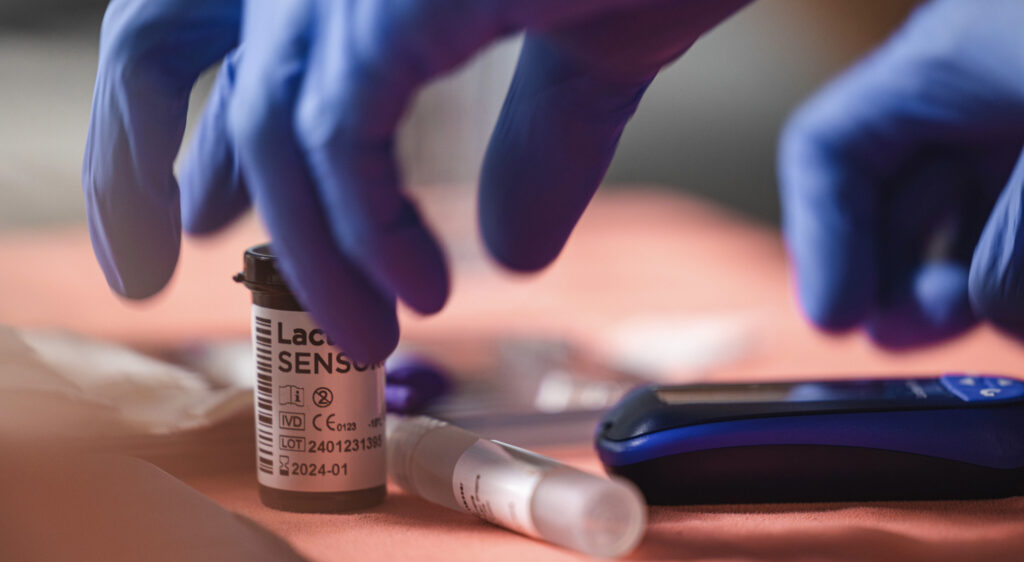
Why Lactate Testing is Imperfect
We also need to be aware of the fact that no lactate testing protocol is perfect. Each protocol has its pros and cons, its strengths and its weaknesses. If you want to get the most out of your testing, you need to know WHY you are using a given protocol and WHAT its limitations are. The better you know your protocol’s limitations, the more equipped you will be to use the results in a concrete way.
Finally, it is the muscle cells that produce lactate. This means that by the time lactate makes its way into the bloodstream, many things can and have happened to it. Learning from the lactate shuttle concept, we know that lactate can be transported to different locations inside the producing cell. Lactate can also be transported (or shuttled) to adjacent cells to be used as fuel. Our liver will convert lactate back to glucose. Our brain and our heart will also use it as fuel. Each individual will produce, transport, and oxidize lactate in different ways.
To sum up this section, it is true that lactate testing has many flaws. We should consider each point carefully before engaging in lactate testing. That being said, it remains, in my opinion, one of the best testing options accessible to athletes today.
Lactate Testing in Running
Runners can perform lactate tests on a treadmill or on the track. I like to start runners at a really easy pace (6-7 km/h) and increase by anywhere from 0.5 to 1 km/h on each step. If I’m testing advanced male runners, we will likely start at 10 km/h and increase by 1km/h on each step. We sample the lactate after every step. We also look at heart rate and RPE (rating of perceived exertion) at the end of every step.
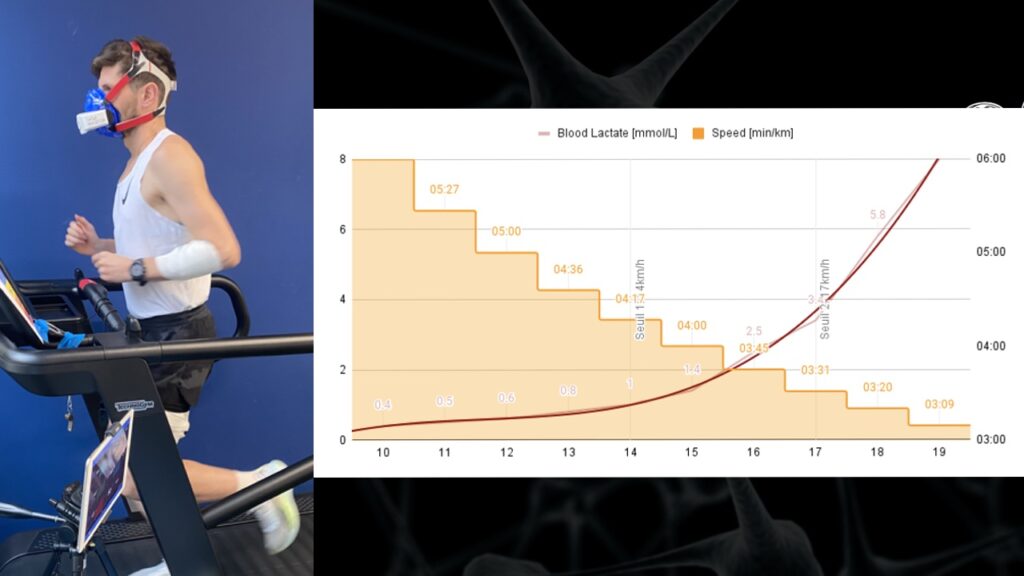
For runners, we express the lactate thresholds as both a running speed and a heart rate. They can then base their training intensities on those values. Most runners tend to run their easy runs too fast. A lactate test enables them to more accurately target the right adaptations and get the most out of their training.
Some runners also use lactate during training, especially during lactate threshold training sessions. Different coaches have different approaches to this practice, but you can find a great article about the Norwegian method here.
Lactate Testing in Cycling
Power-based testing (like “FTP” testing) is fairly common in cycling circles. Using this approach, the athlete uses a performance metric (e.g. max average power over 20 minutes) to estimate the lactate threshold. From that single data point, power “zones” are calculated as percentages of this P20 (power over 20′). The main limitation of this approach is that it doesn’t account for individual differences. What I mean is that two athletes with the same P20 might have significantly different first thresholds. This has a significant impact on intensity distribution and how training is performed for each athlete.
By using a lactate test in cycling, athletes can more confidently set their training intensities knowing that these are based on their own physiology rather than a set percentage of an (arbitrary) performance measure. Lactate tests can be performed on the road or on a home trainer. There can be significant differences between indoor and outdoor riding. This should be taken into account when testing and when training as well. Testing lactate using a calibrated power meter and a heart rate strap will provide the most useful results.
Mathieu Lambert on Lactate Testing VS FTP in Cycling

Mathieu Lambert is the founder of Cyclisme Performance. Website – Free Course [FR] on Training your Digestive System
“Since the 20-minute test requires a maximum effort and therefore a very high motivation, it is possible that the motivation factor influences the results, especially if the athlete has to do 20-minute tests after each training bloc. This is also true for MAP or critical power tests.
Conversely, a lactate test does not necessarily require a maximal effort and therefore can be repeated more regularly, thus allowing reliable monitoring of physiological adaptations in response to a bloc of training.
In addition, the 20-minute test can also be influenced by effort management, unlike the lactate test, which is conducted using pre-determined power outputs.”
Read Mat’s full article on FTP vs Lactate Testing in Cycling
Lactate Testing in Triathlon
Training for triathlons essentially means you have to train for three different disciplines. As we saw in previous sections, athletes can benefit from using individualized training intensities that are based on their unique physiology. This adds a layer of difficulty since a triathlete has to (ideally) test himself in each discipline to train appropriately.
Contrary to what some might think, we cannot simply test a triathlete on the bike and transfer his/her heart rate zones to the run or swim. We can cite three different reasons for this: First, the amount of muscle mass involved in cycling, running, and swimming is different. Second, the body’s position in space is different. Running will almost always elicit higher heart rates than cycling simply because of gravity. And thirdly, the muscles don’t contract in the same way in different disciplines. These factors force us to test each modality independently in order to acquire correct and relevant values for training in them.
Performing a lactate test in running and cycling for a competitive triathlete is a no-brainer. If you dedicate large amounts of time to your training each week, you should at the very least train using accurate values. However, performing a lactate test in the swim is a different story. Because of the technical skill that swimming requires, I advise triathletes to first work with a swim coach and focused on the development of a strong foundation in swimming technique. Once the technical aspect is taken care of, we ca perform a lactate test in the pool.
Learn more about the Norwegian triathlon team’s approach to lactate testing.
Jorge Martinez on Lactate Testing in Long Course Triathlon

Jorge is the Head Coach at E3 Tri Coaching and Director at The FreeSpeed lab. You can also read his substack here.
“In triathlon, it’s common for coaches/athletes to rely on methods such as the Critical Power model or Functional Threshold Power (FTP) to determine training zones. These do a great job identifying the crossover point for the heavy/severe domain, which can be an important marker for short course races like Olympic distance.
However, calculating training zones as a percentage of CP or FTP may not accurately estimate the crossover point for the moderate/heavy domain, which is a crucial marker for long course distances. For instance, training around this intensity provides the most specificity for Ironman. It also helps estimate athletes’ durability from a simple test. Finally, it can allow for better intensity control as the training load increases.
Therefore, lactate testing can allow for identifying the moderate/heavy domain crossover point (LT1) more accurately in a practical way”
Lactate Testing in CrossFit
For many, CrossFit is NOT an endurance sport. I agree that most CrossFit competitive events fall short of the typical endurance sport time domain. That being said, we should highlight the demands imposed by training for the sport itself, rather than the competition alone. Indeed, being good at CrossFit requires athletes to develop a wide range of technical and physical qualities. This takes a lot of time. And when we talk about training time, we HAVE to talk about endurance.
Endurance training allows the CrossFit athlete to train more, to train harder, and ultimately to perform better in their sport. In light of that fact, lactate testing becomes a potent tool for the CrossFitter who wished to improve their work capacity, their recovery, their fatigue resistance, and their metabolic conditioning.
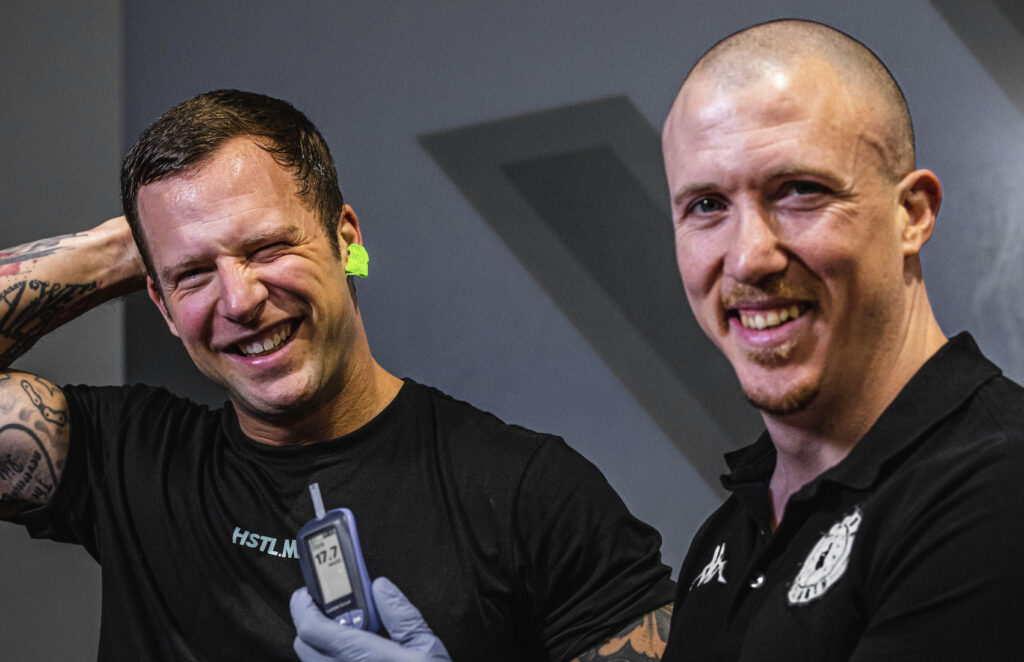
I’ve been fortunate to work with many CrossFit competitors. The overwhelming majority report a very significant transfer of the general endurance training I prescribe (mainly performed on the BikeErg) over to their training and their sport. While Metabolic Conditioning forms the foundation of the CrossFit Pyramid (above nutrition), many have left this aspect aside in favor of high-intensity “WODs” performed multiple times per week. The consequence of this is that most CrossFit athletes have an endurance deficit.
High-intensity training is a strong stimulus for beginners, but intermediate and especially advanced athletes need a more balanced training structure. Lactate testing thus gives the athlete the ability to train at the right intensities to continue their metabolic development.
Upside Strength Lactate Testing: Protocol 41
Put simply, Protocol 41 is the best compromise I’ve found in terms of lactate testing protocols. Using Protocol 41, I’ve been able to test athletes across many sports and successfully individualize and optimize their training. I’ve been lucky to work with cyclists, runners, triathletes, rowers, sailors, CrossFit competitors, MMA athletes, boxers, volleyball players, soccer players, handball players, and more.
If you want to perform a lactate test with Upside Strength, you can contact us here.
If you want to learn more about how you can apply Protocol 41 to improve your own conditioning, visit the Protocol 41 presentation page.
Frequently Asked Questions about Lactate Testing
Lactate testing is a way to assess an athlete’s metabolic profile. It informs us on their strength and weaknesses and helps us orient their training to improve their conditioning.
In a sports context, lactate is measured inside the blood. The sample is usually taken at the earlobe or at the finger using a lancet, a lactate analyzer, and a disposable lactate strip.
Lactate is expressed as a volume in mmol/L of blood.
Lactate test results help coaches and athletes individualize training intensities, orient training plan decisions, and track the athlete’s metabolic profile and progress over time.
Normal lactate levels at rest are usually between 0.5 and 2.5 mmol/L. Lactate levels during intense exercise can increase up to over 20 mmol/L for highly trained athletes such as elite rowers or professional track cyclists.
A lactate test allows an athlete to determine their unique and individual metabolic profile, individualize their training intensities, track their progress over time as well as determine training priorities.
We measure blood lactate in sports to identify the body’s response to different intensities, effort durations and training protocols.
Athletes can measure their lactate (not lactic acid) using a lactate analyzer.
It is easier to pause your effort to sample lactate. Before taking your measurement, you must clean the sampling area, prick the skin to get a droplet of blood, clean off the first drop, and sample the second drop with your analyzer and lactate strip.
Lactate is the end product of glycolysis (the breakdown of sugars like glucose and glycogen). This means that your are producing lactate at rest as you read these lines. Every sport uses the glycolytic system. That being said, short and intense sports such as rowing to track cycling rely more on this energetic pathway than longer events like marathon running or ultra cycling.
VO2 max is not the same as the lactate threshold. The lactate threshold occurs when the body transitions from a stable internal state to an unstable internal state (loss of homeostatic balance). VO2 max always occurs beyond the lactate threshold, when the body can no longer stabilize itself internally.
Blood lactate is a fuel. By improving your ability to transport and utilize lactate, your can improve your endurance performance and your recovery speed.
Lactate rises in a non-linear fashion as intensity increases during exercise.
Additional Resources on Lactate Testing
Conclusion
I hope this guide has answered your most pressing questions about lactate testing for athletes. Despite its limitations, lactate testing remains a time-tested and sound way to individualize training, track progress, and inform training decisions.
If you’d like me to cover other aspects of lactate testing, feel free to contact me directly.
Happy testing, and happy training!

Author
Sean Seale – Upside Strength
Sean is a Performance Coach specializing in physiological testing for CrossFit and Endurance Sports athletes (cycling, running, triathlon, swimming, etc.). Sean also works as a consultant and trainer for gym owners, sports organizations (regional and national), and coaches wishing to deepen their knowledge or their approach in this area.
